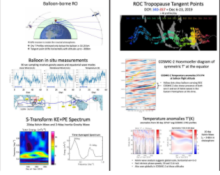Surfing Tropical Waves in the Lower Stratosphere: Inferences on Waves and Winds from Long-Duration Super-Pressure Balloons and Balloon-borne Radio Occultation Profiles
M. Joan
Alexander
NWRA-Boulder
Poster
Winds in Earths lower stratosphere oscillate eastward and westward approximately every other year in what is called the Quasi-Biennial Oscillation or “QBO”. The phase of the QBO is a demonstrated source of skill for weather prediction at subseasonal to seasonal timescales through its modulation of tropical precipitation and Northern Hemisphere winter weather patterns. Global weather and climate models are therefore seeking to simulate the QBO with sufficient realism to represent these important teleconnections to the surface, but numerous challenges remain. Wave-mean flow interaction theory shows that waves dissipate near but below their critical levels (where the wave phase propagation speed matches the local wind speed), and the wave dissipation drags the wind toward the wave phase speed to create the descending QBO wind signal with time. The challenge is that tropical waves display a very wide range of variability on all space and time scales from global and seasonal to mesoscale and minutes, and it turns out the details of the waves that drive the QBO winds matter quite a lot if the goal is simulation of QBO teleconnections.
New inferences on tropical waves and their interactions with QBO winds are emerging from analysis of long-duration super-pressure balloon observations in the tropical lower stratosphere. In particular the Strateole-2 Project, a French-US collaboration, completed its first phase November 2019 through February 2020 that included 8 balloons with different payload configurations drifting for 2-3 months each. For our wave studies we use winds inferred from the Lagrangian motions of the balloons, in situ temperature measurements, and specially designed vertical profiling instruments. Several case studies using balloon-borne radio-occultation measurements reveal very large horizontal scale waves with extremely short vertical wavelengths. Diagnosis of wave momentum fluxes and propagation suggest that these individual wave events provide significant fractions of the force required to drive the QBO descent over multiple days. Despite having large horizontal scales, the short vertical scales of these waves have made them difficult to observe and accurately model, and it has been even more challenging to quantify their effects on the global circulation. Our results have clear and important lessons for global models seeking to simulate a realistic QBO and its teleconnections.
New inferences on tropical waves and their interactions with QBO winds are emerging from analysis of long-duration super-pressure balloon observations in the tropical lower stratosphere. In particular the Strateole-2 Project, a French-US collaboration, completed its first phase November 2019 through February 2020 that included 8 balloons with different payload configurations drifting for 2-3 months each. For our wave studies we use winds inferred from the Lagrangian motions of the balloons, in situ temperature measurements, and specially designed vertical profiling instruments. Several case studies using balloon-borne radio-occultation measurements reveal very large horizontal scale waves with extremely short vertical wavelengths. Diagnosis of wave momentum fluxes and propagation suggest that these individual wave events provide significant fractions of the force required to drive the QBO descent over multiple days. Despite having large horizontal scales, the short vertical scales of these waves have made them difficult to observe and accurately model, and it has been even more challenging to quantify their effects on the global circulation. Our results have clear and important lessons for global models seeking to simulate a realistic QBO and its teleconnections.

Poster PDF